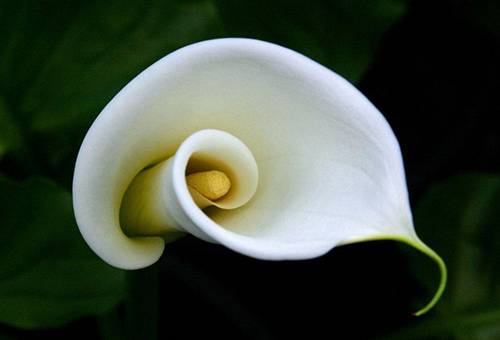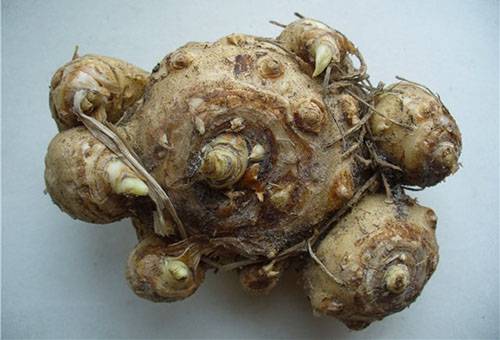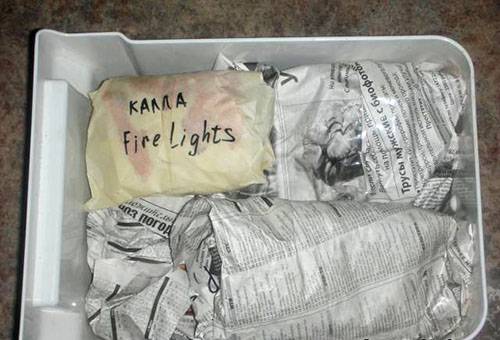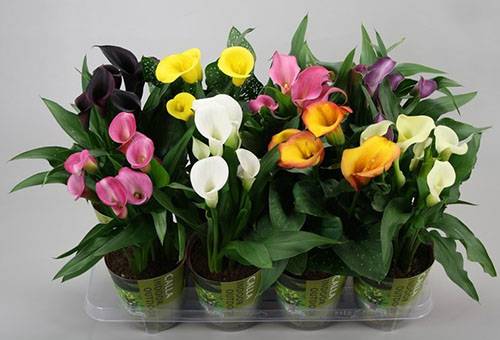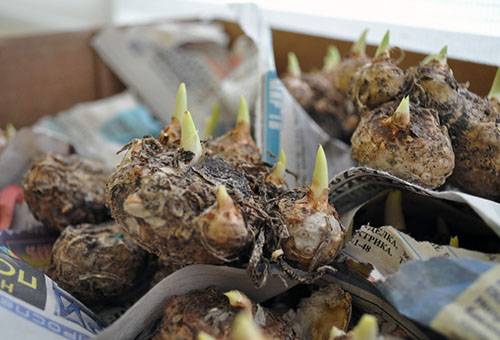Five tips on how to store callas at home in winter
Content:
Callas are beautiful flowering perennials, they can be grown as a pot culture, or can be planted in the garden. With the advent of the first frosts, the question arises: how to store callas in the winter? For productive wintering, they need a temperature of at least -2ºС. Not all climatic zones differ in such mild winter weather, so these perennials need to be dug up for the winter to create optimal conditions for them.
How to dig callas?
The time for this technological operation is after the first frost, tentatively:
- early October in the middle lane,
- early November - in more southern regions.
No need to fear that the first small frosts will damage the plant. On the contrary, it will be a signal to him about the end of the vegetative period. The plant will stop wasting nutrients on leaf formation when it begins to prepare for the dormant period.
Before digging up callas, you need to prepare the plant. To do this, they stop watering it if the weather is dry, about 2-3 weeks before the expected harvest for the winter. This advice is relevant for the southern regions, where a dry climate in the fall is far from uncommon. Before digging, you need to trim the calla leaves above the soil level by about 7-8 cm. After the first frosts, the foliage has already dried up, and this operation is easy to carry out with ordinary scissors.
Tip
It is best to dig calla root tubers with garden pitchforks. So less likely to damage the delicate parts of the plant.
Digging up callas, it is advisable to leave a sufficiently large distance around their roots. It is better to play it safe and dig a hole of a larger diameter than to treat a plant injured by a shovel or pitchfork. After digging, you need to carefully remove soil from its roots, being careful not to damage them. You can rinse off any remaining soil with running water under a tap or garden hose. Make sure the jet is not too strong. A large pressure of water can damage the "calla" children, who have not yet separated from the adult plant.
Dry Calla Lilies
Having dug up calla tubers that you yourself have grown, you will most likely be surprised at their striking difference from the planting material that you purchased before planting in your own garden. Now these are strong, large and beautiful specimens. Before setting aside the root tubers for drying, they need to be thoroughly inspected.
Tubers with signs of rotting should be discarded. If this is a particularly valuable variety, and the damage is minor, you need to strip the damaged tissue to a healthy foundation. This is best done with a teaspoon or a sharp garden tool.
Tip
Damaged and stripped tuber tissue should be decontaminated with a solution of ordinary brilliant green or sprinkled with crushed charcoal. Activated carbon can be used for this purpose.
Rejected material must be disposed of, but never placed in a compost heap. Such actions can contribute to the spread of the disease to other plants. For drying root tubers at home, low cardboard or wooden boxes are best suited. You can use fruit crates made of plastic, lined with cardboard or old newspapers.
Conditions for high-quality drying of callas:
- dark and cool place;
- good air circulation;
- lack of sunlight;
- temperature is not higher than 15-20⁰С.
The best rooms can be a garage, a ventilated dry cellar or basement, a barn.Boxes with callas rhizomes are best placed in one row. After a few days, you need to completely remove the dry leaves, and after a week and the roots, which by this time will be removed very easily. When the roots are not removed, the plant may not start growing in time, without having fully passed the dormant period.
It is not necessary to separate the "children" from the mother plant during this period. They have not fenced off it with a special film - there is a great danger of causing injury to the plant. The department of "children" is rational to conduct in the winter. Then they ripen and can serve as a full planting material. If this happens, the site of damage is dried and again disinfected with brilliant green or charcoal. The drying period can take from two to three weeks - depending on the humidity of the surrounding air.
Bookmark callas for winter storage
So what do you need to prepare for wintering? First of all, suitable containers. The best option for this would be paper bags or cardboard boxes with vents. In the case of storing a large collection of various varieties, they must be signed so that in the spring not to be mistaken in the selection of colors when composing a composition of callas. The best material for this would be a dense foil - the material is not rotting or deteriorating.
Tip
The name of the variety can be written on the foil, squeezing the letters with a regular pen or knitting needle. The tag is attached to the bag or to the wall of the box.
The main condition for proper storage is isolation of root tubers from each other, air circulation between them. In order to isolate the tubers from each other, a substrate is poured into the bag or in the box between the tubers, which can be used as:
- moss;
- sawdust;
- vermiculitis;
- shavings.
If a diseased specimen gets into such a storage at home, the insulation will reliably protect other tubers from rot.
Tip
Although high humidity is not welcome, shriveled and too dried tubers need to be sprayed with spray water to prevent them from drying out.
The optimum temperature for storing root tubers of callas is 5-7 ° C. Ideal conditions for their storage - a fairly dry room, which has good ventilation. If this is a basement, then the harvest must not be stored in it. During storage, fruits and vegetables release moisture and ethylene gas. These factors provoke too early awakening of tubers, as well as their rot. If it is impossible to allocate a separate room, then you should at least try to equip the basement with a separate compartment with extractor fan or forced ventilation.
It is desirable that there is no lighting, so as not to provoke plants to start vegetation too early. The rest period takes from two months or more. It takes so much time for the plant to fully recover. All this time you need to closely monitor their health, periodically inspecting the tubers.
Potted plant wintering
When callas are grown as a home plant, they also need a dormant period. To do this, the pot with the plant after flowering is moved to a cool and dark place in order to stimulate the end of the growing season. Watering the plants also needs to be reduced. You can dig up the tubers and process them using the above technology, or you can leave them wintering directly in the pot or in the container.
Wake up callas with the arrival of spring
In order to complete the wintering, the best period for the middle lane will be the beginning of April, for the southern regions - the beginning of March. Callas root tubers are taken out, carefully examined, treated with a solution of manganese or any fungicide from fungal diseases. If the "children" were not separated from callas in winter, you can separate them now.
Tip
"Children" are not cut off from the mother plant, but are broken off. The place of separation must be disinfected, treated with brilliant green, sprinkled with ash.
In order for these beautiful plants to painlessly endure the period of winter dormancy, you need to dig them up correctly, dry them and provide them with storage in a dry and cool place.
